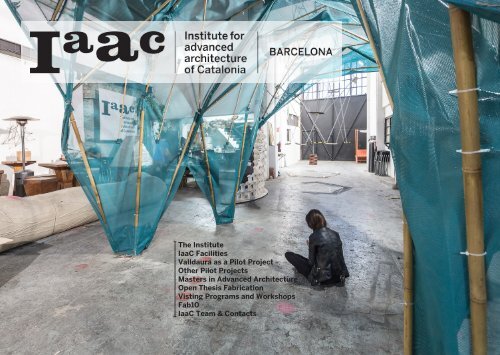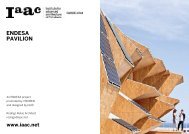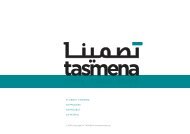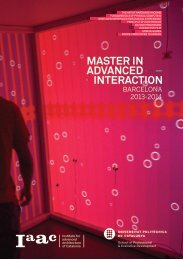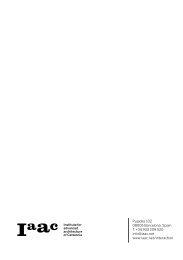Download PDF Presentation of IaaC (3.4MB) - Institute for Advanced ...
Download PDF Presentation of IaaC (3.4MB) - Institute for Advanced ...
Download PDF Presentation of IaaC (3.4MB) - Institute for Advanced ...
Create successful ePaper yourself
Turn your PDF publications into a flip-book with our unique Google optimized e-Paper software.
The <strong>Institute</strong><br />
<strong>IaaC</strong> Facilities<br />
Valldaura as a Pilot Project<br />
Other Pilot Projects<br />
Masters in <strong>Advanced</strong> Architecture<br />
Open Thesis Fabrication<br />
Visting Programs and Workshops<br />
Fab10<br />
<strong>IaaC</strong> Team & Contacts
THE INSTITUTE<br />
The <strong>Institute</strong> <strong>for</strong> <strong>Advanced</strong><br />
Architecture <strong>of</strong> Catalonia (<strong>IaaC</strong>)<br />
is a leading centre in research and<br />
education in the field <strong>of</strong> <strong>Advanced</strong><br />
Architecture, with a project <strong>of</strong> digital<br />
fabrication and self-sufficiency<br />
considered a reference in Europe,<br />
as well as contributing to making<br />
Barcelona become the world’s first<br />
Productive and Self-Sufficient city.<br />
The <strong>Institute</strong> <strong>of</strong>fers multidisciplinary<br />
Master Programs and Postgraduate<br />
programs, developed in close<br />
collaboration with companies, and<br />
a global network <strong>of</strong> select faculty, all<br />
specialised in their diverse fields.<br />
IAAC PROGRAMS<br />
MASTER IN ADVANCED<br />
ARCHITECTURE<br />
- INTELLIGENT CITIES<br />
- SELF SUFFICIENT BUILDINGS<br />
- DIGITAL MATTER<br />
- DESIGN WITH NATURE<br />
- ADVANCED INTERRACTION<br />
OPEN THESIS<br />
FABRICATION<br />
- INTELLIGENT BUILDING CONSTRUCTION<br />
- SMART URBAN ELEMENTS<br />
- 3D PRINTING IN ARCHITECTURAL CONSTRUCTION<br />
FAB ACADEMY<br />
For more in<strong>for</strong>mation visit:<br />
www.iaac.net<br />
Or contact:<br />
applications@iaac.net
IAAC<br />
INTERNATIONAL<br />
RANKINGS<br />
The past 10 years <strong>of</strong> research and<br />
development in the Academic<br />
field have been rewarded with<br />
global recognition. <strong>IaaC</strong>, as an<br />
educational centre, is featured<br />
in several international rankings,<br />
being considered among the best<br />
graduate schools in the world.<br />
Among these: Domus Top 100<br />
Schools in 2013 and 2014, by<br />
Obras in 2013, by GA Graduate<br />
Architecture in 2013, and many<br />
more.
@22 CAMPUS<br />
The Barcelona 22@ campus is located in the <strong>of</strong> the<br />
Poblenou neighbourhood, an innovative district<br />
<strong>of</strong>fering a strategic concentration <strong>of</strong> intensive<br />
knowledge-based activities. The neighbourhood<br />
is near the historic centre <strong>of</strong> Barcelona and the<br />
seafront. <strong>IaaC</strong> is housed in an old factory building,<br />
with 2,000m2 <strong>of</strong> space dedicated to research and<br />
production. In this way the space itself is a declaration<br />
<strong>of</strong> principles, embodying an advanced, experimental<br />
and productive approach to architecture.<br />
For more in<strong>for</strong>mation visit:<br />
www.iaac.net
FAB LAB BARCELONA<br />
The <strong>IaaC</strong> premises also include the , an architecture<br />
and design-oriented fabrication laboratory which<br />
is part <strong>of</strong> the global network <strong>of</strong> Fab Labs set up by<br />
at MIT. The Fab Lab is equipped with a series <strong>of</strong><br />
flexible computer controlled tools that cover several<br />
different lengths, scales and various materials,<br />
allowing students to build prototypes, also in 1:1<br />
scales. The machines include: Laser cutters, a 3-axis<br />
computer-controlled subtractive milling machines,<br />
robotic arms, rapid prototypers such as 3D printers,<br />
microprocessors, digital electronic equipment and<br />
more.<br />
FAB LAB<br />
BARCELONA<br />
For more in<strong>for</strong>mation visit:<br />
www.fablabbcn.org<br />
New Logo<br />
Helvetica Neue LT Pro - 75 Bold<br />
Pantone DS 77-1*<br />
Pantone DS 202-1*<br />
Pantone DS 272-1*<br />
Pantone DS 325-3*<br />
Black (C50 M50 Y50 K100)<br />
*All CMYK (Pantone Process)<br />
FAB LAB<br />
BARCELONA<br />
New Logo<br />
Helvetica Neue LT Pro -<br />
New Logo<br />
Vector<br />
Pantone DS 77-1*<br />
Pantone DS 202-1*<br />
Pantone DS 272-1*<br />
Pantone DS 325-3*<br />
Black (C50 M50 Y50 K100)<br />
*All CMYK (Pantone Process)<br />
New Logo<br />
Vector<br />
New Logo<br />
RGB<br />
R218 G33 B40<br />
R22 G50 B92<br />
R0 G140 B79<br />
R113 G113 B113<br />
FAB LAB<br />
BARCELONA<br />
New Logo<br />
Helvetica Neue LT Pro -
VALLDAURA LABS<br />
The is a research center <strong>for</strong> self-sufficient habitats,<br />
located on an historic 130 hectare farm in the 20<br />
minutes from downtown Barcelona. As part <strong>of</strong> <strong>IaaC</strong>’s<br />
commitment to promote habitability on the basis<br />
<strong>of</strong> ecological principles, making the fullest use <strong>of</strong><br />
all available technologies and resources, <strong>IaaC</strong> has<br />
created a research centre focused on the idea <strong>of</strong><br />
self-sufficiency. Valldaura Labs is a testing ground<br />
allowing to learn directly from nature in order to<br />
apply this understanding to the regeneration <strong>of</strong> XXIst<br />
century cities.<br />
For more in<strong>for</strong>mation visit:<br />
www.valldaura.net
ENERGY LAB<br />
The Energy Lab <strong>of</strong> Can Valldaura is<br />
intended to develop a new model <strong>for</strong><br />
the management and distribution <strong>of</strong><br />
energy in buildings from renewable<br />
resources; biomass, solar, wind, working<br />
in partnership with Endesa.<br />
Using this system we will be able to<br />
evaluate energy use, timing, intensities<br />
etc in order to effectively reduce overall<br />
consumption.<br />
VALLDAURA LABS<br />
VISION<br />
To be an international centre <strong>of</strong> education and<br />
research on the self-sufficient human habitat in order<br />
to bring influential technologies and solutions to bear<br />
on the production <strong>of</strong> energy, food and things and<br />
contribute our territorial vision to the trans<strong>for</strong>mation<br />
<strong>of</strong> Barcelona and the cities <strong>of</strong> the world.<br />
MISSION<br />
Make a centre financially self-sufficient, from<br />
educational, research, and events, developing the full<br />
potential <strong>of</strong> the property functional related to the core<br />
<strong>of</strong> the farmhouse, the restaurant, the palace and the<br />
whole natural system.<br />
VALUES<br />
<strong>IaaC</strong>’s Valldaura Self Sufficient Labs campus and its<br />
three laboratories — Food Lab, Energy Lab and Green<br />
FabLab — allow to research the production <strong>of</strong> key<br />
elements involved in self-sufficiency: food, energy and<br />
things, combining ancestral knowledge that connects<br />
us to nature with the latest advanced technology.<br />
Wind Energy Machines<br />
We5<br />
Alejandro Martinez del Campo, Alessio Salvatore Verdolino,<br />
Hriday Siddarth Saini, Ricardo Perez Borbolla, Tobias<br />
Grumstrup Lund Øhrstrøm<br />
Permaculture Workshop<br />
Mariano Bueno<br />
Kuka Chainsaw Workshop<br />
Tom Pawl<strong>of</strong>sky<br />
FOOD LAB<br />
Humans need the energy we get from food.<br />
Valldaura was an agricultural area in the<br />
early twentieth century and now recovers<br />
an activity that generates biodiversity in<br />
Collserola Park. Food production is based<br />
in different culture <strong>for</strong>mats, including<br />
organic gardens, orchard plantations,<br />
edible <strong>for</strong>est products that come from<br />
farm animals, and is run entirely by<br />
students and researchers.<br />
GREEN FAB LAB<br />
Valldaura´s GreenFabLab subscribes to<br />
the same open and enabling philosophy to<br />
explore the frontier between technology,<br />
environment and people. Creating a local<br />
manufacturing hub involved in providing<br />
products and solutions to all aspects <strong>of</strong><br />
humans daily needs from the materials<br />
that can be found only on site; and<br />
propose to add the ancestral knowledge<br />
<strong>of</strong> crafts to new technologies bringing<br />
together artisans, artists and artificers,<br />
working together to investigate, improve<br />
and innovate the tools required to build<br />
a self-sufficient community within the<br />
Collserola national park <strong>of</strong> Barcelona.
VALLDAURA LABS<br />
A IAAC PILOT PROJECT<br />
“Valldaura is a current testbed <strong>for</strong> further research and<br />
development on Self Sufficiency, Internet <strong>of</strong> Energy,<br />
Internet <strong>of</strong> Water and Digital Fabrication”<br />
ENERGRID<br />
Energrid project aims to develop a distributed infrastructure<br />
<strong>for</strong> buildings energy management. The project is funded by<br />
Endesa and developed by IAAC in partnership with i2Cat<br />
Foundation. Energrid integrates an ecosystem <strong>of</strong> wireless<br />
intelligent plu gs, sensors and energy generation systems<br />
on a single plat<strong>for</strong>m allowing to create logics that manage<br />
buildings energy consumption, generation and storage.<br />
Valldaura is the main laboratory where the Energrid project<br />
is currently being tested in order to become a show room <strong>of</strong><br />
the technology.<br />
Each building energy consumption point is equipped with<br />
an intelligent node capable <strong>of</strong> measuring and actuating.<br />
Buildings are linked in an electrical network being able to<br />
produce, consume and store energy while sharing it with<br />
the other buildings.<br />
HYDROGRID<br />
HydroGrid is a project that promotes the development <strong>of</strong><br />
a new holistic concept <strong>of</strong> water management, considering<br />
unitlevel solutions, with a multi scalar applicability.<br />
In relation to the current management system, Hydrogrid<br />
proposes the combination <strong>of</strong> four innovative concepts:<br />
First, management is proposed based on the diversification<br />
<strong>of</strong> water sources from the fact that not all applications<br />
require the same quality water. Second, it is proposed<br />
the concept <strong>of</strong> recycling and reuse <strong>of</strong> water, similar to the<br />
current management model in the field <strong>of</strong> waste. Third,<br />
treatment and reuse in-site. Instead <strong>of</strong> gathering all the<br />
different water flow rates and lead as a unit to centralized<br />
treatment facilities, this concept provides treatment site<br />
reuse. Fourth, provisioning intelligence in each <strong>of</strong> the scales<br />
<strong>of</strong> the water cycle to allowing the active management <strong>of</strong><br />
consumption.<br />
The project aims to develop a test-bed in Valldaura where to<br />
put in practice all the project concepts and technologies in<br />
a single system.<br />
VALLDAURA SELF SUFFICIENT LABS:<br />
A SELF-SUFFICIENT TERRITORY.
ENDESA PAVILION<br />
OTHER IAAC<br />
PILOT PROJECTS<br />
As part <strong>of</strong> <strong>IaaC</strong>’s commitment to investigate lessexplored<br />
areas <strong>of</strong> the Architectural discipline, pilot<br />
projects are launched on a yearly basis.<br />
These projects operate in the field between academia,<br />
architecutal practice and in<strong>for</strong>mation technologies,<br />
and are designed and fabricated entirely within the<br />
premises <strong>of</strong> Iaac in 22@ district, by Iaac faculty.<br />
The projects completed to date include the Fab Lab<br />
House, Endesa Pavilion, Hyperhabitat, Smart Citizen<br />
Kit to name a few and operate in a number <strong>of</strong> scales,<br />
from 1:1 architectural interventions to pocket-sized<br />
microprocessors, all sharing a common vision <strong>of</strong><br />
investigation towards a more sustainable and socially<br />
empowering design approach. All projects have been<br />
welcomed with considerable success, with various<br />
distinctions in events such as the Solar Decathlon and<br />
the Venice Biennale.<br />
ENDESA Pavilion is a self-sufficient solar<br />
prototype installed at the Marina Dock, within<br />
the framework <strong>of</strong> the International BCN Smart<br />
City Congress. At the moment it is used as<br />
control room <strong>for</strong> monitoring and testing<br />
several projects related to intelligent power<br />
management.<br />
The pavillion is actually the prototype <strong>of</strong> a multiscale<br />
construction system. A facade composed<br />
by modular components, much like solar<br />
bricks, that respond to photovoltaic gaining,<br />
solar protection, insulation, ventilation, lighting.<br />
The same parametric logic helps adapt façade<br />
geometries to the specific environmental<br />
requirements <strong>for</strong> each point <strong>of</strong> the building. It is<br />
is a single component that integrates all levels<br />
<strong>of</strong> intelligence that the building needs.<br />
From “<strong>for</strong>m follows function” (classic XX<br />
century statement) to “<strong>for</strong>m follows energy”.<br />
The facade opens reacting to the solar path,<br />
being active and becoming permeable towards<br />
south, while becoming closed and protective<br />
towards north. The behavior <strong>of</strong> this skin makes<br />
the environmental and climatic processes that<br />
surround the prototype visible.<br />
photos by Adrià Goula<br />
In the process, Iaac collaborates with a network <strong>of</strong><br />
partners from various disciplines, including leading<br />
universities and innovative companies.<br />
For more in<strong>for</strong>mation visit:<br />
www.iaac.net/projects
FAB LAB HOUSE<br />
The Fab Lab House Project lead by the <strong>Institute</strong><br />
<strong>for</strong> <strong>Advanced</strong> Architecture <strong>of</strong> Catalonia, the<br />
Center <strong>for</strong> Bit and Atoms, MIT and a world<br />
wide network <strong>of</strong> fab labs was part <strong>of</strong> the Solar<br />
Decathlon Europe competition.<br />
The 1:1 prototype is parametrically designed<br />
based on the parameters <strong>of</strong> longitude and<br />
latitude <strong>of</strong> the geographical place where it is<br />
to be implemented. The parametric digital<br />
model is able to generate the most optimum<br />
<strong>for</strong>m based on that parameters so that the<br />
building could capture the maximum <strong>of</strong> solar<br />
energy during the whole year. The design goes<br />
beyond aesthetics and designer decisions<br />
and introduces the in<strong>for</strong>mation <strong>of</strong> solar path<br />
and energy capturing as the base <strong>for</strong> the final<br />
design. Form follows energy.<br />
Furthermore, the prototype has been entirely<br />
fabricated in the <strong>IaaC</strong> premises within the<br />
digital fabrication laboratory manifesting<br />
the capability <strong>of</strong> small scale workshops to<br />
contribute into the local fabrication not only <strong>of</strong><br />
small objects but <strong>of</strong> entire buildings as well.<br />
This enhances principles <strong>of</strong> sustainability<br />
referring to the construction process or material<br />
transportation promoting efficiency in all levels<br />
<strong>of</strong> a self sufficient building construction.<br />
photos by Adrià Goula<br />
IN COLLABORATION WITH:<br />
SMART CITIZEN<br />
Smart Citizen is a plat<strong>for</strong>m to generate<br />
participatory processes <strong>of</strong> people in the cities.<br />
Connecting data, people and knowledge, the<br />
objective <strong>of</strong> the plat<strong>for</strong>m is to serve as a node<br />
<strong>for</strong> building productive and open indicators, and<br />
distributed tools, and thereafter the collective<br />
construction <strong>of</strong> the city <strong>for</strong> its own inhabitants.<br />
The Smart Citizen project is based on<br />
geolocation, Internet and free hardware and<br />
s<strong>of</strong>tware <strong>for</strong> data collection and sharing (Smart<br />
Citizen Kit - SCK , RESTful api, Mobile App<br />
and, the web community), and the production<br />
<strong>of</strong> objects; it connects people with their<br />
environment and their city to create more<br />
effective and optimized relationships between<br />
resources, technology, communities, services<br />
and events in the urban environment. Currently<br />
it is being deployed as initial phase in Barcelona<br />
city.<br />
IN COLLABORATION WITH:
HYPERHABITAT<br />
Hyperhabitat is an <strong>IaaC</strong> project <strong>for</strong> the 2008<br />
Venice Biennale ‘Out There: Architecture<br />
Beyond Building’, curated by Aaron Betsky.<br />
<strong>IaaC</strong>’s participation consists in a project in<br />
collaboration with Guallart Architects, The<br />
Center <strong>for</strong> Bits and Atoms at MIT and Bestiario.<br />
The project entitled ‘Hyperhabitat:<br />
Reprogramming the World’, sought to take<br />
the idea <strong>of</strong> the multiscale habitat to the limit.<br />
Hyperhabitat is a model <strong>for</strong> defining the<br />
physical world and its compatibility with the<br />
digital world using the principles <strong>of</strong> a network.<br />
The project defines a multiscale structure<br />
that can use the same principles to link any<br />
element <strong>of</strong> the physical world capable <strong>of</strong> having<br />
a digital identity, so that the world can be reprogrammed<br />
by identifying new relational<br />
systems composed <strong>of</strong> local and global systems.<br />
Hyperhabitat uses the technology <strong>of</strong> Internet 0<br />
(internet <strong>of</strong> things) developed at the MIT, CBA<br />
and it is the largest-ever installation using this<br />
microcomputer technology.<br />
IN COLLABORATION WITH:<br />
DATA NET<br />
In the courtyard <strong>of</strong> the Museu Frederic Marés<br />
DATA NET is born, another tree next to the<br />
existing ones.This new tree <strong>for</strong>ms an interactive<br />
mesh covering the patio <strong>of</strong> the museum.<br />
You see the installation illuminated but you also<br />
find yourselves, as a visitor, participating in the<br />
project. The intensity <strong>of</strong> light <strong>of</strong> the installation<br />
reacts to the location and the density <strong>of</strong> the<br />
visitors through a series <strong>of</strong> sensors that track<br />
people´s movement.<br />
Visitors are not only observers <strong>of</strong> a space<br />
but participants in its creation, definition and<br />
variation.<br />
DATA NET is reflecting a living organism that<br />
moves and evolves according to the data<br />
generated by the public.<br />
photos by Filippo Poli<br />
IN COLLABORATION WITH:<br />
FOR:<br />
FOR:
OCEANIA 0 0 0 0 0 2 0 2 0 0 0 1<br />
NORTH AMERICA 3 4 6 4 6 8 3 13 7 11 12 14<br />
CENTRAL AMERICA 0 2 0 0 6 4 2 2 3 2 3 4<br />
SOUTH AMERICA 4 1 1 1 3 4 3 9 7 3 6 5<br />
30<br />
25<br />
Europe<br />
Asia<br />
20<br />
EUROPE<br />
IAAC ALUMNI<br />
A GLOBAL<br />
NETWORK<br />
The <strong>Institute</strong> and Master Program Directors,<br />
together with the teaching staff, are<br />
committed to a long-term prospectus <strong>of</strong><br />
creating an international research and<br />
academic network, on a global scale, centered<br />
in Barcelona. This network brings together<br />
international students, tutors and researchers<br />
from different fields <strong>of</strong> expertise materializing<br />
experimental <strong>for</strong>ms <strong>of</strong> communication,<br />
inhabitation and planning.<br />
15<br />
10<br />
5<br />
0<br />
2002/20032003/20042004/20052005/20062006/20072007/20082008/20092009/20102010/20112011/20122012/20132013/2014<br />
AFRICA<br />
MIDDLE EAST<br />
ASIA<br />
North America<br />
Oceania<br />
Africa<br />
OCEANIA<br />
NORTH AMERICA<br />
CENTRAL AMERICA<br />
Middle East<br />
SOUTH AMERICA<br />
South America<br />
Central America<br />
In this way <strong>IaaC</strong> becomes the centre <strong>of</strong> a global<br />
Networked Hub, promoting collaboration<br />
as well as the exchange <strong>of</strong> knowledge, <strong>for</strong><br />
Research and Innovation <strong>for</strong> the Habitability <strong>of</strong><br />
the XXIst Century.<br />
In this sense, over the last ten years, <strong>IaaC</strong> has<br />
received and been home to over 500 students<br />
from more than 60 countries, including China,<br />
the UK, the USA, Australia, the Dominican<br />
Republic, Mexico, Argentina, Puerto Rico,<br />
Ecuador, Peru, Germany, Iran, Thailand,<br />
Turkey, India, Poland, Cyprus, Portugal,<br />
Italy, Greece, Spain, Guatemala, Bangladesh,<br />
Colombia, Korea and more making it an<br />
exceptionally international and multicultural<br />
place.<br />
<strong>IaaC</strong> Students and Alumni<br />
2000-2014
MASTERS IN<br />
ADVANCED<br />
ARCHITECTURE<br />
The <strong>IaaC</strong>’s Masters in <strong>Advanced</strong> Architecture (MAA)<br />
focuses on new ideas <strong>for</strong> Future Cities and Buildings,<br />
Self Sufficiency, Digital Manufacturing Techniques,<br />
Advaced Interaction and In<strong>for</strong>mation Technologies.<br />
MULTIDISCIPLINARY<br />
MASTER PROGRAM<br />
SHAPING THE FUTURE OF<br />
CITIES, ARCHITECTURE<br />
AND TECHNOLOGY.<br />
In order to allow highest quality and applied research,<br />
the Masters in <strong>Advanced</strong> Architecture proposes a<br />
multi-disciplinary approach, considering architecture<br />
as a transversal field, <strong>for</strong> which it is imperative to<br />
integrate all research and applications with the<br />
knowledge <strong>of</strong> specialits from a diversity <strong>of</strong> fields <strong>of</strong><br />
expertise.<br />
Hence the 14th edition <strong>of</strong> the MAA emerges as an<br />
Innovative Structure focusing on 5 select Research<br />
Lines (Intelligent Cities, Self Sufficient Buildings,<br />
Digital Matter, Design with Nature, <strong>Advanced</strong><br />
Interaction) all led by internationally renound experts,<br />
and mixing students and faculty from different<br />
disciplines and origines, towards the creation <strong>of</strong> a<br />
Networked Hub <strong>for</strong> Research and Innovation <strong>for</strong> the<br />
Habitability <strong>of</strong> the XXIst Century.<br />
For more in<strong>for</strong>mation visit:<br />
www.iaac.net<br />
www.iaacblog.com
RS1 - INTELLIGENT CITIES<br />
Senior Faculty: Willy Müller in collaboration<br />
with SCI-ARC, Hernán Díaz Alonso<br />
Intelligent Cities Studio works on projects that<br />
range from territorial scale to the neighborhood<br />
scale. This is based on 2 premises: the<br />
understanding that countries and cities with<br />
emerging economies and cultures - by virtue<br />
<strong>of</strong> their regional or economic position - can<br />
contribute in great value to the planet as a<br />
whole; and the creation <strong>of</strong> intelligent territories<br />
that function in a multiscalar way, creating<br />
relations between nature, networks and nodes,<br />
while promoting the ‘emergence’ <strong>of</strong> an urban<br />
intelligence.<br />
RS2 - SELF SUFFICIENT BUILDINGS<br />
Senior Faculty : Enric Ruiz Geli + Mireia<br />
Luzárraga<br />
Self Sufficient Buildings Studio works on<br />
scales that range from urban blocks to<br />
individual buildings developing principles and<br />
techniques <strong>for</strong> homes, that serve to organize<br />
the materialization <strong>of</strong> programmatic nodes <strong>of</strong><br />
activity based on natural rules and principles.<br />
As a result, the building goes beyond being a<br />
mere interface <strong>for</strong> the economic activities it<br />
houses to being an environment that stimulates<br />
its inhabitants and functions as an active part<br />
<strong>of</strong> the ecosystem in which it is inserted.<br />
RS3 - DIGITAL MATTER<br />
INTELLIGENT CONSTRUCTIONS<br />
Senior Faculty: Areti Markopoulou in<br />
collaboration with CITA, Mette Ramsgaard<br />
Thomsen<br />
Digital Matter Studio explores how intelligent<br />
constructions in architecture go beyond<br />
traditional materials, working with digital<br />
content, in<strong>for</strong>mation and fabrication <strong>for</strong> the<br />
generation <strong>of</strong> new techniques towards the<br />
production <strong>of</strong> non-rigid, responsive and multifunctional<br />
material and construction systems.<br />
Focusing on smart materials, able to adjust<br />
their properties to different environmental<br />
conditions, we study the possibilities <strong>of</strong><br />
programming buildings from a nanoscale,<br />
and opening a new series <strong>of</strong> applications from<br />
architectural to industrial scale.<br />
When Energy Becomes Form<br />
Hygroscopic Morpholodgy // Kaleigroscope<br />
Valldaura Labs<br />
Students // Niel Parekh // Stephanie<br />
Bashir // Rodion Eremeev // Rodolfo<br />
Parolin Hardy<br />
RS4 - DESIGN WITH NATURE<br />
Senior Faculty: Javier Peña in collaboration<br />
with Collserola Metropolitan Parc.<br />
Design with Nature Studio is based on the<br />
principle <strong>of</strong> “learning by doing”, centering its<br />
studies in the sustainable habitat, it approaches<br />
four central aspects: food production, energy<br />
production, objects production and social<br />
interaction. The studio will use the case study<br />
<strong>of</strong> <strong>IaaC</strong>’s Valldaura Self Sufficient Labs campus<br />
and its three laboratories — Food Lab, Energy<br />
Lab and Green FabLab — allowing to research<br />
the production <strong>of</strong> key elements involved in selfsufficiency:<br />
food, energy and things, combining<br />
ancestral knowledge that connects us to nature<br />
with the latest advanced technology.<br />
RS5 - ADVANCED INTERACTION<br />
Senior Faculty: Xavier Gonzalez & Carlos<br />
Gomez in collaboration with diverse ICT<br />
companies<br />
<strong>Advanced</strong> Interaction Studio focuses on the<br />
use <strong>of</strong> technology within the boundaries <strong>of</strong><br />
the human habitat exploring this context’s<br />
potential. Based on the analysis and design<br />
<strong>of</strong> devices and systems, this research studio<br />
generates creative uses <strong>of</strong> technology <strong>for</strong><br />
experimental and practical purposes. The<br />
learning-by-doing research metho integrates<br />
techniques used in design, programming and<br />
social sciences towards projects, prototypes<br />
and products that define the outer limits<br />
<strong>of</strong> what is possible to do imaginatively with<br />
technology today.
OPEN THESIS<br />
FABRICATION<br />
The course is open to students and pr<strong>of</strong>essionals<br />
who would like to develop a specific research agenda<br />
within the field <strong>of</strong> digital design and fabrication.<br />
The program focuses on the development and<br />
completion <strong>of</strong> full scale prototypes using advanced<br />
CNC machinery, applying experimental materials<br />
and testing smart energy solutions. The researchers’<br />
projects will be monitored by experienced tutors,<br />
and regularly discussed with external guests and<br />
consultants with specific expertise in the field. The<br />
program takes place in partnership with companies,<br />
<strong>of</strong>fering advisory pannels every two weeks discussing<br />
further development <strong>of</strong> these projects.<br />
IN COLLABORATION WITH:<br />
For more in<strong>for</strong>mation visit:<br />
www.iaac.net<br />
www.iaacblog.com/openthesis/<br />
Matearial<br />
Anti·gravity Object Modeling<br />
OTF 2012 -Petr Novikov, Saša Jokic<br />
A brand new method <strong>of</strong> additive<br />
manufacturing. This patentpending<br />
method allows <strong>for</strong> creating 3D<br />
objects on any given working<br />
surface independently <strong>of</strong> its<br />
inclination and smoothness, and<br />
without a need <strong>of</strong> additional support<br />
structures. By using innovative<br />
extrusion technology we are now<br />
able to neutralize the effect <strong>of</strong><br />
gravity during the course <strong>of</strong> the<br />
printing process.<br />
This method gives us a flexibility<br />
to create truly natural objects<br />
by making 3D curves instead <strong>of</strong><br />
2D layers. Unlike 2D layers that<br />
are ignorant to the structure <strong>of</strong><br />
the object, 3D curves can follow<br />
exact stress lines <strong>of</strong> a custom<br />
shape. Finally, our new out <strong>of</strong> the<br />
box printing method can help<br />
manufacture structures <strong>of</strong> almost<br />
any<br />
size and shape.<br />
IN COLLABORATION WITH:<br />
Joris Laarsman Lab
Pylos<br />
OTF 2013 - S<strong>of</strong>oklis<br />
Giannakopoulos<br />
Pylos explores the<br />
possibilities <strong>of</strong> Roboticaided<br />
3D Printing with<br />
clay. Such a technology<br />
would open new<br />
possibilities to In-Situ<br />
clay construction, both<br />
in an urban and in a rural<br />
setting.<br />
IN COLLABORATION<br />
WITH:<br />
D-Shape and Monolite<br />
Enrico Dini
HelioCELL, Global Summer School 2012<br />
VISITING PROGRAMS<br />
AND WORKSHOPS<br />
GLOBAL SUMMER SCHOOL<br />
<strong>IaaC</strong> develops a series <strong>of</strong> short visiting programs,<br />
under the <strong>for</strong>m <strong>of</strong> workshops, opening the educational<br />
and research developed in <strong>IaaC</strong> to outside users<br />
interested in learning and participating in these<br />
processes. In doing so <strong>IaaC</strong> consolidates its already<br />
strong Global network.<br />
One <strong>of</strong> these is the Global Summer School, a 3 week<br />
program, investigating multiscalar strategies <strong>for</strong> the<br />
(re) construction <strong>of</strong> our inhabiting environments<br />
(home, city, planet). The last few years <strong>of</strong><br />
technological, social, political, economic and cultural<br />
changes (at both the global and the local scale)<br />
demand that we rethink what kind <strong>of</strong> habitat humanity<br />
will live in in the coming decades, given that space in<br />
all its aspects (landscapes, cities, places, buildings<br />
and bodies) is undergoing dramatic trans<strong>for</strong>mations.<br />
<strong>of</strong> the evolution <strong>of</strong> the city and architecture.<br />
DISTRIBUTED EDUCATIONAL MODEL<br />
IAAC GSS is an initiative which seeks to generate a<br />
dynamic network based on distributive knowledge<br />
and collective actions. As part <strong>of</strong> this initiative the<br />
Global Summer School takes place in different cities<br />
at the same time in Australia, Asia, Europe, Africa,<br />
South America, and North America.<br />
For more in<strong>for</strong>mation visit:<br />
www.iaac.net/educational-programs/<br />
workshops-28<br />
www.iaac.net/educational-programs/<br />
global-summer-school-21
VISITING PROGRAMS<br />
AND WORKSHOPS<br />
FAB LAB WORKSHOPS<br />
Digital Fabrication workshops oriented to<br />
pr<strong>of</strong>essionals and non-pr<strong>of</strong>essionals that want to<br />
anlargen their knowledge base regarding the diverse<br />
fabrication technologies.<br />
OPEN WORKSHOPS<br />
The workshops are open to participants without<br />
previous knowledge or required diploma.<br />
There is no limitation in the age <strong>of</strong> the participants.<br />
Those workshops give the opportunity to all users<br />
from whichever dicipline to get familiarized with<br />
technology and learn-by-doing.<br />
Some <strong>of</strong> the most relevant <strong>of</strong> these experiences:<br />
DIY Lights, Scanning and 3D printing, Furniture<br />
Fabrication and Object Production, Arduino:<br />
electronics and programming, Fab Kids, Fab Skate,<br />
Fab Textiles, Smart Citizen, and much more.<br />
For more in<strong>for</strong>mation visit:<br />
www.fablabbcn.org<br />
www.fablabbcn.org/category/workshops/<br />
Images from various Fab Lab Bcn Workshops
FAB 10<br />
FAB10 Barcelona is the tenth international conference<br />
and annual meeting <strong>of</strong> the Fab Lab network. Fab10<br />
Barcelona will gather the international Fab Lab<br />
community from more than 150 laboratories based<br />
in more than 40 countries, who share tools, projects,<br />
programs and processes in an open and collaborative<br />
philosophy.<br />
DIGITAL FABRICATION<br />
Additive Manufacturing / New Materials / Bio<br />
Fabrication / Subtractive Fabrication / Self-Assembly<br />
Structures / Codes into Materials / Material<br />
Computation<br />
2 - 8 JULY 2014<br />
BARCELONA<br />
THE 10TH INTERNATIONAL<br />
FAB LAB CONFERENCE<br />
PRODUCTIVE CITIES<br />
New Manufacturing / Cities Infrastructure <strong>for</strong> Citizen<br />
Innovation / Public Policy in the Making / Emergent<br />
Economies / Reindustrialisation <strong>of</strong> Cities<br />
EMERGENT COMMUNITIES<br />
Crowdsourcing Knowledge / Crowd-Funding Projects<br />
/ Co-working / Collaborative and Sharing Economy<br />
For more in<strong>for</strong>mation visit:<br />
www.fab10.org<br />
Interested in sponsoring the event<br />
Contact: fab10@fablabbcn.org<br />
FROM FAB LABS TO FAB CITIES
IAAC TEAM AND CONTACTS<br />
IAAC<br />
FOUNDATION<br />
SCIENTIFIC<br />
COMMITTEE<br />
IAAC<br />
TEAM<br />
BOARD OF TRUSTEES<br />
Oriol Soler, President<br />
Andreu Blay, Secretary<br />
Robert Brufau (UPC)<br />
Sebastiá Sallent (UPC)<br />
Ramon Ruiz<br />
Francesc Fernandez<br />
Willy Müller<br />
Lucas Cappelli<br />
Rafael Diez Torelló (ROCA)<br />
José Maria Milá Mencos (Santa&Cole)<br />
Lluís-Xavier Comerón Graupera (COAC)<br />
EXECUTIVE BOARD<br />
Oriol Soler<br />
Lucas Cappelli<br />
Ramon Ruiz<br />
Andreu Blay<br />
Sebastià Sallent<br />
Vicente Guallart, President<br />
(Architect, Chief City Architect <strong>of</strong> Barcelona)<br />
Nader Tehrani<br />
(Architect, Director MIT School Architecture,<br />
Boston)<br />
Juan Herreros<br />
(Architect, Pr<strong>of</strong>essor ETSAM, Madrid)<br />
Neil Gershenfeld<br />
(Physic, Director CBA MIT, Boston)<br />
Hanif Kara<br />
(Engineer, Director AKT, London)<br />
Willy Müller<br />
(Director <strong>of</strong> Barcelona Regional)<br />
Aaron Betsky<br />
(Architect & Art Critic, Director Cincinnati<br />
Art Museum, Cincinnati)<br />
Hugh Whitehead<br />
(Engineer, Director Foster + Partners<br />
technology, London)<br />
Nikos A. Salingaros<br />
(Pr<strong>of</strong>essor at the University <strong>of</strong> Texas, San<br />
Antonio)<br />
Dean<br />
Manuel Gausa<br />
Master Programs Director<br />
Research and Development<br />
Areti Markopoulou - areti@iaac.net<br />
Academic Coordinator<br />
Silvia Brandi - coordinator@iaac.net<br />
Fab Lab BCN Director<br />
Tomas Díez - tomasdiez@iaac.net<br />
Fab Lab BCN Manager<br />
Luciano Betoldi - luciano@fablabbcn.org<br />
Fab Lab BCN Coordinator<br />
Anastasia Pist<strong>of</strong>idou - anastasia@fablabbcn.org<br />
Communication & Publications<br />
Mathilde Marengo - mathilde.marengo@iaac.net<br />
Valldaura Labs<br />
Nuria Diaz<br />
Valldaura Labs Coordinator<br />
Ana Martinez<br />
Research and Development<br />
Guillem Camprodon - guillem@iaac.net<br />
Assistant Manager<br />
Ana Martí - management@iaac.net<br />
Academic Secretary<br />
Luciana Asinari - luciana.asinari@iaac.net<br />
Administration<br />
Xavi Cejudo - administration@iaac.net<br />
Technical Support<br />
Jorge Ramirez<br />
Web Master<br />
Xavi Gonzalez - xavi@iaac.net<br />
<strong>Advanced</strong> Architecture Contest<br />
Lucas Cappelli - lucascappelli@iaac.net<br />
Publication Advisor<br />
Ramon Prat - ACTAR<br />
Salvador Rueda<br />
(Ecologist, Director Agencia Ecologia<br />
Urbana, Barcelona)<br />
Artur Serra<br />
(Anthropologist, Director I2CAT, Barcelona)<br />
Computation Tech Advisor<br />
Luis Fraguada - luis@iaac.net<br />
Research and Development<br />
Alexandre Dubor - alexandre.dubor@iaac.net<br />
Green Fab Lab Coordinator<br />
Jonathan Minchin - jonathan@fablabbcn.org
Contact in<strong>for</strong>mation:<br />
www.iaac.net<br />
www.iaacblog.com<br />
www.fablabbcn.org<br />
www.fab10.org<br />
www.valldaura.net<br />
info@iaac.net<br />
applications@iaac.net<br />
info@fablabbcn.org<br />
fab10@fablabbcn.org<br />
valldaura@iaac.net<br />
Front and back cover image:<br />
Angeliki Terezaki, Borgani Harsh Shailesh, Marjan Jelveh<br />
Nejad, Anand Singh, Elif Gungor, Ibrahim Bercay Ogunc,<br />
Kismir Selcuk, Zeynep Birgonul<br />
Directors <strong>of</strong> the Seminar: Josep Mias, Silvia Brandi<br />
photos by Filippo Poli


